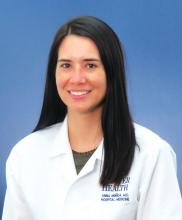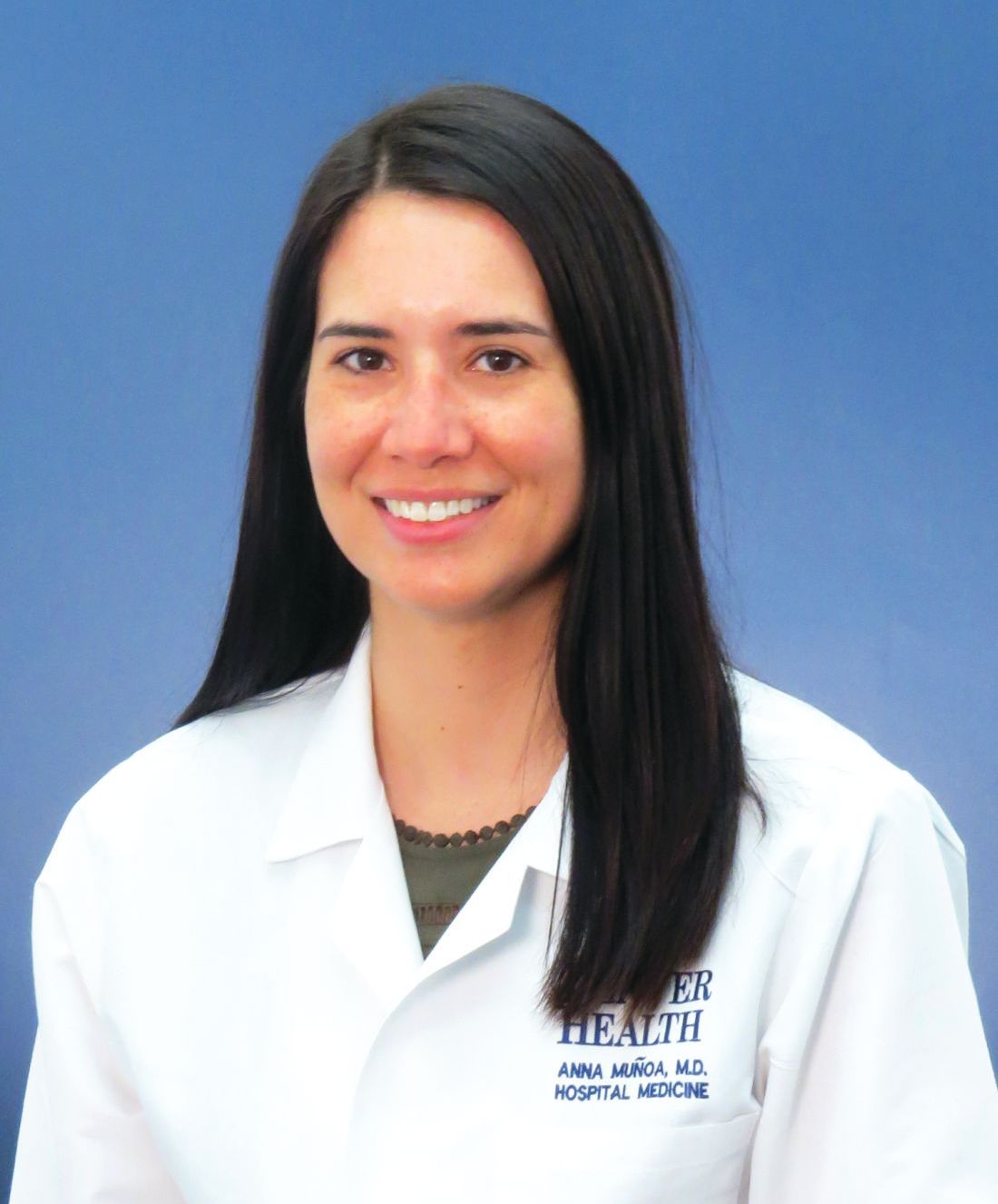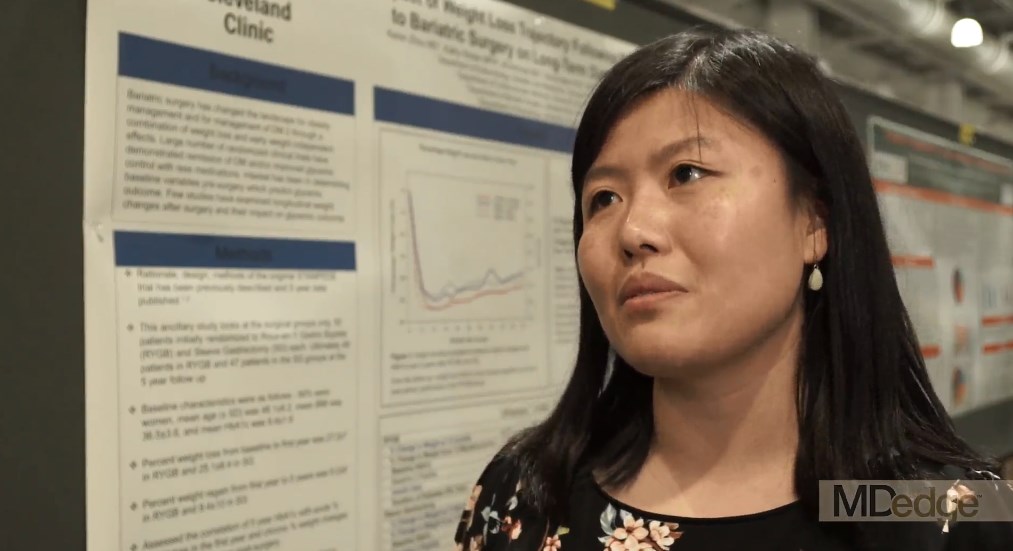User login
MDedge Daily News: Heart rate variability a risk factor for depression?
Also, results of the SYGMA1 and SYGMA1 trials show that as-needed budesonide-formoterol prevented exacerbations in mild asthma, patients with Parkinson’s disease may have impaired insulin secretion, and FDA commissioner Scott Gottlieb floats ideas on Medicare drug coverage. Listen to the MDedge Daily News podcast for all the details on today’s top news.
Also, results of the SYGMA1 and SYGMA1 trials show that as-needed budesonide-formoterol prevented exacerbations in mild asthma, patients with Parkinson’s disease may have impaired insulin secretion, and FDA commissioner Scott Gottlieb floats ideas on Medicare drug coverage. Listen to the MDedge Daily News podcast for all the details on today’s top news.
Also, results of the SYGMA1 and SYGMA1 trials show that as-needed budesonide-formoterol prevented exacerbations in mild asthma, patients with Parkinson’s disease may have impaired insulin secretion, and FDA commissioner Scott Gottlieb floats ideas on Medicare drug coverage. Listen to the MDedge Daily News podcast for all the details on today’s top news.
Better matching for blood transfusions
Researchers have developed software that could enable more precise matching for blood transfusions, according to a paper published in The Lancet Haematology.
The software, bloodTyper, can automatically type red blood cell (RBC) and platelet antigens from whole-genome sequencing (WGS) data.
In repeated tests, bloodTyper produced results that were more than 99% concordant with results from conventional antigen typing methods.
The researchers said these results suggest bloodTyper could improve transfusion typing.
“[W]ith current technology, it is not cost-effective to do blood typing for all antigens,” said study author William Lane, MD, PhD, of Brigham and Women’s Hospital in Boston, Massachusetts.
“But the algorithm we have developed can be applied to type everyone for all relevant blood groups at a low cost once sequencing is obtained.”
Dr Lane and his colleagues first tested bloodTyper using data from the MedSeq Project—the first randomized trial of WGS in healthy adults.
Blood samples from 110 subjects underwent DNA isolation, WGS, and RBC and platelet antigen typing with bloodTyper. Samples also underwent single nucleotide polymorphism (SNP) array typing and serological typing.
The researchers compared results with these typing methods and found that bloodTyper was 99.5% concordant with serological and SNP typing across the first 20 MedSeq genomes.
Further refinement of bloodTyper enabled improved concordance for the remaining 90 genomes. The researchers said bloodTyper was 99.8% concordant with serological and SNP typing methods for 38 RBC and 22 platelet antigens (encoded by 17 RBC and 6 platelet genes).
The team made additional modifications to bloodTyper and tested it with 200 genomes from the INTERVAL study. This time, bloodTyper was 99.2% concordant with serological methods for typing of 21 RBC antigens encoded by 14 genes.
When the researchers adjusted for the lower depth of coverage for INTERVAL genomes compared to MedSeq genomes (15× and 30×, respectively), they observed 99.9% concordance between serological typing and bloodTyper.
“This approach has the potential to be one of the first routine clinical uses of genomics for medical care for patients needing blood transfusion,” said study author Connie M. Westhoff, PhD, of the New York Blood Center in New York, New York.
“It could prevent serious or even fatal complications because, once patients are sensitized, they have a life-long risk of hemolytic transfusion reactions if blood transfusion is needed in an emergency.”
Researchers have developed software that could enable more precise matching for blood transfusions, according to a paper published in The Lancet Haematology.
The software, bloodTyper, can automatically type red blood cell (RBC) and platelet antigens from whole-genome sequencing (WGS) data.
In repeated tests, bloodTyper produced results that were more than 99% concordant with results from conventional antigen typing methods.
The researchers said these results suggest bloodTyper could improve transfusion typing.
“[W]ith current technology, it is not cost-effective to do blood typing for all antigens,” said study author William Lane, MD, PhD, of Brigham and Women’s Hospital in Boston, Massachusetts.
“But the algorithm we have developed can be applied to type everyone for all relevant blood groups at a low cost once sequencing is obtained.”
Dr Lane and his colleagues first tested bloodTyper using data from the MedSeq Project—the first randomized trial of WGS in healthy adults.
Blood samples from 110 subjects underwent DNA isolation, WGS, and RBC and platelet antigen typing with bloodTyper. Samples also underwent single nucleotide polymorphism (SNP) array typing and serological typing.
The researchers compared results with these typing methods and found that bloodTyper was 99.5% concordant with serological and SNP typing across the first 20 MedSeq genomes.
Further refinement of bloodTyper enabled improved concordance for the remaining 90 genomes. The researchers said bloodTyper was 99.8% concordant with serological and SNP typing methods for 38 RBC and 22 platelet antigens (encoded by 17 RBC and 6 platelet genes).
The team made additional modifications to bloodTyper and tested it with 200 genomes from the INTERVAL study. This time, bloodTyper was 99.2% concordant with serological methods for typing of 21 RBC antigens encoded by 14 genes.
When the researchers adjusted for the lower depth of coverage for INTERVAL genomes compared to MedSeq genomes (15× and 30×, respectively), they observed 99.9% concordance between serological typing and bloodTyper.
“This approach has the potential to be one of the first routine clinical uses of genomics for medical care for patients needing blood transfusion,” said study author Connie M. Westhoff, PhD, of the New York Blood Center in New York, New York.
“It could prevent serious or even fatal complications because, once patients are sensitized, they have a life-long risk of hemolytic transfusion reactions if blood transfusion is needed in an emergency.”
Researchers have developed software that could enable more precise matching for blood transfusions, according to a paper published in The Lancet Haematology.
The software, bloodTyper, can automatically type red blood cell (RBC) and platelet antigens from whole-genome sequencing (WGS) data.
In repeated tests, bloodTyper produced results that were more than 99% concordant with results from conventional antigen typing methods.
The researchers said these results suggest bloodTyper could improve transfusion typing.
“[W]ith current technology, it is not cost-effective to do blood typing for all antigens,” said study author William Lane, MD, PhD, of Brigham and Women’s Hospital in Boston, Massachusetts.
“But the algorithm we have developed can be applied to type everyone for all relevant blood groups at a low cost once sequencing is obtained.”
Dr Lane and his colleagues first tested bloodTyper using data from the MedSeq Project—the first randomized trial of WGS in healthy adults.
Blood samples from 110 subjects underwent DNA isolation, WGS, and RBC and platelet antigen typing with bloodTyper. Samples also underwent single nucleotide polymorphism (SNP) array typing and serological typing.
The researchers compared results with these typing methods and found that bloodTyper was 99.5% concordant with serological and SNP typing across the first 20 MedSeq genomes.
Further refinement of bloodTyper enabled improved concordance for the remaining 90 genomes. The researchers said bloodTyper was 99.8% concordant with serological and SNP typing methods for 38 RBC and 22 platelet antigens (encoded by 17 RBC and 6 platelet genes).
The team made additional modifications to bloodTyper and tested it with 200 genomes from the INTERVAL study. This time, bloodTyper was 99.2% concordant with serological methods for typing of 21 RBC antigens encoded by 14 genes.
When the researchers adjusted for the lower depth of coverage for INTERVAL genomes compared to MedSeq genomes (15× and 30×, respectively), they observed 99.9% concordance between serological typing and bloodTyper.
“This approach has the potential to be one of the first routine clinical uses of genomics for medical care for patients needing blood transfusion,” said study author Connie M. Westhoff, PhD, of the New York Blood Center in New York, New York.
“It could prevent serious or even fatal complications because, once patients are sensitized, they have a life-long risk of hemolytic transfusion reactions if blood transfusion is needed in an emergency.”
Bacterial signals set the stage for PMP
Preclinical research suggests bacterial signals are crucial to the development of pre-leukemic myeloproliferation (PMP).
Researchers found that bacterial translocation leads to increased production of interleukin-6 (IL-6), which prompts PMP development in mice with Tet2 deficiency.
However, antibiotics and blockade of IL-6 were able to reverse PMP in the mice.
Bana Jabri, MD, PhD, of the University of Chicago in Illinois, and her colleagues reported these findings in Nature.
The researchers noted that, in humans and mice, TET2 deficiency leads to increased self-renewal of hematopoietic stem cells favoring the myeloid lineage, and this can lead to PMP.
However, not all humans or mice with TET2 deficiency actually develop PMP, which suggests other factors are at play.
With this in mind, the researchers studied Tet2-deficient mice. The team found that loss of Tet2 expression leads to defects in the intestinal barrier, although it isn’t clear how this occurs.
The intestinal defects allow bacteria living in the gut to spread into the blood and peripheral organs. The spread of bacteria prompts an increase in IL-6. This promotes proliferation of granulocyte–macrophage progenitors that express high levels of IL-6Rα in the absence of Tet2, and this leads to PMP.
The researchers found they could induce PMP in symptom-free Tet2−/− mice by disrupting intestinal barrier integrity. PMP also developed in response to systemic bacterial stimuli.
However, antibiotics and blockade of IL-6 signals could reverse PMP in mice that developed symptoms. And germ-free Tet2−/− mice did not develop symptoms, which supports the idea that bacteria must be present to drive the development of PMP.
Dr Jabri said the next step is to conduct studies in humans to see if patients with PMP also have signs of bacterial translocation. Then, clinical trials could test whether treatments that target aberrant IL-6 signals in response to bacteria can reverse the course of PMP.
Preclinical research suggests bacterial signals are crucial to the development of pre-leukemic myeloproliferation (PMP).
Researchers found that bacterial translocation leads to increased production of interleukin-6 (IL-6), which prompts PMP development in mice with Tet2 deficiency.
However, antibiotics and blockade of IL-6 were able to reverse PMP in the mice.
Bana Jabri, MD, PhD, of the University of Chicago in Illinois, and her colleagues reported these findings in Nature.
The researchers noted that, in humans and mice, TET2 deficiency leads to increased self-renewal of hematopoietic stem cells favoring the myeloid lineage, and this can lead to PMP.
However, not all humans or mice with TET2 deficiency actually develop PMP, which suggests other factors are at play.
With this in mind, the researchers studied Tet2-deficient mice. The team found that loss of Tet2 expression leads to defects in the intestinal barrier, although it isn’t clear how this occurs.
The intestinal defects allow bacteria living in the gut to spread into the blood and peripheral organs. The spread of bacteria prompts an increase in IL-6. This promotes proliferation of granulocyte–macrophage progenitors that express high levels of IL-6Rα in the absence of Tet2, and this leads to PMP.
The researchers found they could induce PMP in symptom-free Tet2−/− mice by disrupting intestinal barrier integrity. PMP also developed in response to systemic bacterial stimuli.
However, antibiotics and blockade of IL-6 signals could reverse PMP in mice that developed symptoms. And germ-free Tet2−/− mice did not develop symptoms, which supports the idea that bacteria must be present to drive the development of PMP.
Dr Jabri said the next step is to conduct studies in humans to see if patients with PMP also have signs of bacterial translocation. Then, clinical trials could test whether treatments that target aberrant IL-6 signals in response to bacteria can reverse the course of PMP.
Preclinical research suggests bacterial signals are crucial to the development of pre-leukemic myeloproliferation (PMP).
Researchers found that bacterial translocation leads to increased production of interleukin-6 (IL-6), which prompts PMP development in mice with Tet2 deficiency.
However, antibiotics and blockade of IL-6 were able to reverse PMP in the mice.
Bana Jabri, MD, PhD, of the University of Chicago in Illinois, and her colleagues reported these findings in Nature.
The researchers noted that, in humans and mice, TET2 deficiency leads to increased self-renewal of hematopoietic stem cells favoring the myeloid lineage, and this can lead to PMP.
However, not all humans or mice with TET2 deficiency actually develop PMP, which suggests other factors are at play.
With this in mind, the researchers studied Tet2-deficient mice. The team found that loss of Tet2 expression leads to defects in the intestinal barrier, although it isn’t clear how this occurs.
The intestinal defects allow bacteria living in the gut to spread into the blood and peripheral organs. The spread of bacteria prompts an increase in IL-6. This promotes proliferation of granulocyte–macrophage progenitors that express high levels of IL-6Rα in the absence of Tet2, and this leads to PMP.
The researchers found they could induce PMP in symptom-free Tet2−/− mice by disrupting intestinal barrier integrity. PMP also developed in response to systemic bacterial stimuli.
However, antibiotics and blockade of IL-6 signals could reverse PMP in mice that developed symptoms. And germ-free Tet2−/− mice did not develop symptoms, which supports the idea that bacteria must be present to drive the development of PMP.
Dr Jabri said the next step is to conduct studies in humans to see if patients with PMP also have signs of bacterial translocation. Then, clinical trials could test whether treatments that target aberrant IL-6 signals in response to bacteria can reverse the course of PMP.
EHRs enhance clinical trial follow-up
Electronic health records (EHRs) can enhance results from randomized controlled trials (RCTs), according to research published in Scientific Reports.
Researchers found EHRs could be used to track trial participants, enabling long-term monitoring of medical interventions and health outcomes and providing new insights into population health.
“In this study, we reported on the feasibility and efficiency of electronic follow-up and compared it with traditional trial follow-up,” said study author Sue Jordan, PhD, MB BCh, of Swansea University in Swansea, UK.
“We gained new insights from outcomes electronically recorded 3 years after the end of the trial and could then identify the differences between trial data and electronic data.”
Dr Jordan and her colleagues followed up on RCT participants using EHRs in the Secure Anonymised Information Linkage (SAIL) databank at Swansea University Medical School.
In this RCT, investigators had assessed the impact of probiotics on asthma and eczema in children born from 2005 to 2007. The trial had 2 years of traditional fieldwork follow-up.
Dr Jordan and her colleagues compared field results to EHR results at 2 years in 93% of trial participants.
The researchers said EHRs improved retention of children from lower socio-economic groups, which helped reduce volunteer bias.
The team also performed electronic follow-up at 5 years, which provided the “first robust analysis of asthma endpoints.”
The researchers said the asthma endpoints are “generally more reliable” in the 5-year EHR data for 2 reasons. The first is that the children are older, and asthma typically appears after 2 years of age.
The second reason is that, with the fieldwork follow-up, parents or guardians may have mistakenly identified symptoms as asthma without a child actually having an asthma diagnosis.
“Trial data are vulnerable to misunderstandings of questionnaires or definitions of illness,” Dr Jordan noted.
She and her colleagues also pointed out that retention was still high (82%) and free of bias in socio-economic status with the 5-year EHR data.
“These results lead us to conclude that using electronic health records have benefits relating to the cost-effective, long-term monitoring of complex interventions, which could have a positive impact for future clinical trial design,” said study author Michael Gravenor, DPhil, of Swansea University.
Electronic health records (EHRs) can enhance results from randomized controlled trials (RCTs), according to research published in Scientific Reports.
Researchers found EHRs could be used to track trial participants, enabling long-term monitoring of medical interventions and health outcomes and providing new insights into population health.
“In this study, we reported on the feasibility and efficiency of electronic follow-up and compared it with traditional trial follow-up,” said study author Sue Jordan, PhD, MB BCh, of Swansea University in Swansea, UK.
“We gained new insights from outcomes electronically recorded 3 years after the end of the trial and could then identify the differences between trial data and electronic data.”
Dr Jordan and her colleagues followed up on RCT participants using EHRs in the Secure Anonymised Information Linkage (SAIL) databank at Swansea University Medical School.
In this RCT, investigators had assessed the impact of probiotics on asthma and eczema in children born from 2005 to 2007. The trial had 2 years of traditional fieldwork follow-up.
Dr Jordan and her colleagues compared field results to EHR results at 2 years in 93% of trial participants.
The researchers said EHRs improved retention of children from lower socio-economic groups, which helped reduce volunteer bias.
The team also performed electronic follow-up at 5 years, which provided the “first robust analysis of asthma endpoints.”
The researchers said the asthma endpoints are “generally more reliable” in the 5-year EHR data for 2 reasons. The first is that the children are older, and asthma typically appears after 2 years of age.
The second reason is that, with the fieldwork follow-up, parents or guardians may have mistakenly identified symptoms as asthma without a child actually having an asthma diagnosis.
“Trial data are vulnerable to misunderstandings of questionnaires or definitions of illness,” Dr Jordan noted.
She and her colleagues also pointed out that retention was still high (82%) and free of bias in socio-economic status with the 5-year EHR data.
“These results lead us to conclude that using electronic health records have benefits relating to the cost-effective, long-term monitoring of complex interventions, which could have a positive impact for future clinical trial design,” said study author Michael Gravenor, DPhil, of Swansea University.
Electronic health records (EHRs) can enhance results from randomized controlled trials (RCTs), according to research published in Scientific Reports.
Researchers found EHRs could be used to track trial participants, enabling long-term monitoring of medical interventions and health outcomes and providing new insights into population health.
“In this study, we reported on the feasibility and efficiency of electronic follow-up and compared it with traditional trial follow-up,” said study author Sue Jordan, PhD, MB BCh, of Swansea University in Swansea, UK.
“We gained new insights from outcomes electronically recorded 3 years after the end of the trial and could then identify the differences between trial data and electronic data.”
Dr Jordan and her colleagues followed up on RCT participants using EHRs in the Secure Anonymised Information Linkage (SAIL) databank at Swansea University Medical School.
In this RCT, investigators had assessed the impact of probiotics on asthma and eczema in children born from 2005 to 2007. The trial had 2 years of traditional fieldwork follow-up.
Dr Jordan and her colleagues compared field results to EHR results at 2 years in 93% of trial participants.
The researchers said EHRs improved retention of children from lower socio-economic groups, which helped reduce volunteer bias.
The team also performed electronic follow-up at 5 years, which provided the “first robust analysis of asthma endpoints.”
The researchers said the asthma endpoints are “generally more reliable” in the 5-year EHR data for 2 reasons. The first is that the children are older, and asthma typically appears after 2 years of age.
The second reason is that, with the fieldwork follow-up, parents or guardians may have mistakenly identified symptoms as asthma without a child actually having an asthma diagnosis.
“Trial data are vulnerable to misunderstandings of questionnaires or definitions of illness,” Dr Jordan noted.
She and her colleagues also pointed out that retention was still high (82%) and free of bias in socio-economic status with the 5-year EHR data.
“These results lead us to conclude that using electronic health records have benefits relating to the cost-effective, long-term monitoring of complex interventions, which could have a positive impact for future clinical trial design,” said study author Michael Gravenor, DPhil, of Swansea University.
Abstract: Divergent Responses to Mammography and Prostate-Specific Antigen Recommendations
The video associated with this article is no longer available on this site. Please view all of our videos on the MDedge YouTube channel
Martinez, K.A., et al, Am J Prev Med 53(4):533, October 2017
The authors, from the Cleveland Clinic, explore the reasons for divergent responses to recent guideline recommendations against screening for breast cancer and prostate cancer. Both cancers are common (lifetime incidence of 12% and 16%, respectively), with indolent forms that are more prevalent with age. Screening with mammography and prostate-specific antigen (PSA) testing achieves earlier detection and relative risk reductions in cancer-specific mortality of 15% to 20%, but negligible effects on overall mortality and a risk of overtreatment that is estimated to be 30% to 80%. Benefits of screening and risks of overtreatment are unclear because of study limitations and evolution in diagnostic criteria, screening and management. Beginning in 2008, the US Preventive Services Task Force downgraded its recommendations for routine mammography (e.g., a rating of C for average-risk women aged 40-49) and for routine PSA testing (rating of D regardless of age). [EDITOR’S NOTE: USPSTF PSA screening recommendations have changed. See “USPSTF advises against widespread prostate cancer screening.”] While objections to the PSA rating were minimal, the public and professional backlash about mammography was profound. Reasons may include unique characteristics of breast (versus prostate) cancer, including mortality at a younger age, financial conflicts of interest (with mammography generating $8 billion per year in the US), bureaucratic incentives (e.g., quality measures, insurance reimbursement), and the influence of profit-generating advocacy groups. Many physicians do not understand the risks and harms of overtreatment or the inability of early detection to prevent metastasis, and patients want to be “better safe than sorry.” Rates of screening mammography may not decrease until truly informed decisions are possible, which will necessitate better algorithms to predict those cancers that are likely to spread. 20 references (martink12@ccf.org – no reprints)
The video associated with this article is no longer available on this site. Please view all of our videos on the MDedge YouTube channel
Martinez, K.A., et al, Am J Prev Med 53(4):533, October 2017
The authors, from the Cleveland Clinic, explore the reasons for divergent responses to recent guideline recommendations against screening for breast cancer and prostate cancer. Both cancers are common (lifetime incidence of 12% and 16%, respectively), with indolent forms that are more prevalent with age. Screening with mammography and prostate-specific antigen (PSA) testing achieves earlier detection and relative risk reductions in cancer-specific mortality of 15% to 20%, but negligible effects on overall mortality and a risk of overtreatment that is estimated to be 30% to 80%. Benefits of screening and risks of overtreatment are unclear because of study limitations and evolution in diagnostic criteria, screening and management. Beginning in 2008, the US Preventive Services Task Force downgraded its recommendations for routine mammography (e.g., a rating of C for average-risk women aged 40-49) and for routine PSA testing (rating of D regardless of age). [EDITOR’S NOTE: USPSTF PSA screening recommendations have changed. See “USPSTF advises against widespread prostate cancer screening.”] While objections to the PSA rating were minimal, the public and professional backlash about mammography was profound. Reasons may include unique characteristics of breast (versus prostate) cancer, including mortality at a younger age, financial conflicts of interest (with mammography generating $8 billion per year in the US), bureaucratic incentives (e.g., quality measures, insurance reimbursement), and the influence of profit-generating advocacy groups. Many physicians do not understand the risks and harms of overtreatment or the inability of early detection to prevent metastasis, and patients want to be “better safe than sorry.” Rates of screening mammography may not decrease until truly informed decisions are possible, which will necessitate better algorithms to predict those cancers that are likely to spread. 20 references (martink12@ccf.org – no reprints)
The video associated with this article is no longer available on this site. Please view all of our videos on the MDedge YouTube channel
Martinez, K.A., et al, Am J Prev Med 53(4):533, October 2017
The authors, from the Cleveland Clinic, explore the reasons for divergent responses to recent guideline recommendations against screening for breast cancer and prostate cancer. Both cancers are common (lifetime incidence of 12% and 16%, respectively), with indolent forms that are more prevalent with age. Screening with mammography and prostate-specific antigen (PSA) testing achieves earlier detection and relative risk reductions in cancer-specific mortality of 15% to 20%, but negligible effects on overall mortality and a risk of overtreatment that is estimated to be 30% to 80%. Benefits of screening and risks of overtreatment are unclear because of study limitations and evolution in diagnostic criteria, screening and management. Beginning in 2008, the US Preventive Services Task Force downgraded its recommendations for routine mammography (e.g., a rating of C for average-risk women aged 40-49) and for routine PSA testing (rating of D regardless of age). [EDITOR’S NOTE: USPSTF PSA screening recommendations have changed. See “USPSTF advises against widespread prostate cancer screening.”] While objections to the PSA rating were minimal, the public and professional backlash about mammography was profound. Reasons may include unique characteristics of breast (versus prostate) cancer, including mortality at a younger age, financial conflicts of interest (with mammography generating $8 billion per year in the US), bureaucratic incentives (e.g., quality measures, insurance reimbursement), and the influence of profit-generating advocacy groups. Many physicians do not understand the risks and harms of overtreatment or the inability of early detection to prevent metastasis, and patients want to be “better safe than sorry.” Rates of screening mammography may not decrease until truly informed decisions are possible, which will necessitate better algorithms to predict those cancers that are likely to spread. 20 references (martink12@ccf.org – no reprints)
Learn more about the Primary Care Medical Abstracts and podcasts, for which you can earn up to 9 CME credits per month.
Copyright © The Center for Medical Education
Guidelines to optimize treatment of reduced ejection fraction heart failure
Clinical question: What guidance is there for clinical care of complex heart failure patients?
Background: The prevalence of heart failure (HF)is escalating and consumes significant health care resources, inflicts significant morbidity and mortality, and greatly affects quality of life. There is a plethora of research, multiple medical therapies, devices, and care strategies that have been shown to improve outcomes in heart failure patients. Previous publications have reviewed evidence-based literature but left a gap in knowledge for those more-complex areas or lacked practical clinical guidance. This policy document was created to guide physicians in informed decision making in a directed decision pathway form.
Study design: Expert consensus guidelines.
Setting: American College of Cardiology Task Force on Expert Consensus Decision Pathways.
Synopsis: A multidisciplinary group of specialties including physicians, nurses, pharmacists, epidemiologists, and patient advocacy groups addressed 10 pivotal issues in heart failure through literature review, expert consensus, and round table discussion.
Ten principles were identified and addressed:
- Initiating, adding, or switching to new evidenced-based guideline-directed therapy.
- Achieving optimal therapy using multiple HF drugs and therapies.
- Knowing when to refer a patient to an HF specialist.
- Addressing the challenges of care coordination for team-based HF treatment.
- Improving patient adherence.
- Managing specific patient cohorts, such as African Americans, older adults, and the frail.
- Managing your patients’ cost of care for HF.
- Reducing costs and managing the increased complexity of HF.
- Managing the most common cardiac and noncardiac comorbidities.
- Integrating palliative care and transitioning patients to hospice care
Bottom line: Structured guidelines to provide practical and actionable recommendations to improve heart failure outcomes, integrate evidence-based medicine when available, and utilize expert conscious when evidence-based medicine is not available.
Citation: Yancy CW et al. 2017 ACC expert consensus on decision pathway for optimizing of heart failure treatment: Answers to 10 pivotal issues about heart failure with reduced ejection fraction. J Am Coll Cardiol. 2018 Jan 16;71(2):201-30.
Dr. Muñoa is a hospitalist at Denver Health Medical Center and an assistant professor of medicine at the University of Colorado at Denver, Aurora.
Clinical question: What guidance is there for clinical care of complex heart failure patients?
Background: The prevalence of heart failure (HF)is escalating and consumes significant health care resources, inflicts significant morbidity and mortality, and greatly affects quality of life. There is a plethora of research, multiple medical therapies, devices, and care strategies that have been shown to improve outcomes in heart failure patients. Previous publications have reviewed evidence-based literature but left a gap in knowledge for those more-complex areas or lacked practical clinical guidance. This policy document was created to guide physicians in informed decision making in a directed decision pathway form.
Study design: Expert consensus guidelines.
Setting: American College of Cardiology Task Force on Expert Consensus Decision Pathways.
Synopsis: A multidisciplinary group of specialties including physicians, nurses, pharmacists, epidemiologists, and patient advocacy groups addressed 10 pivotal issues in heart failure through literature review, expert consensus, and round table discussion.
Ten principles were identified and addressed:
- Initiating, adding, or switching to new evidenced-based guideline-directed therapy.
- Achieving optimal therapy using multiple HF drugs and therapies.
- Knowing when to refer a patient to an HF specialist.
- Addressing the challenges of care coordination for team-based HF treatment.
- Improving patient adherence.
- Managing specific patient cohorts, such as African Americans, older adults, and the frail.
- Managing your patients’ cost of care for HF.
- Reducing costs and managing the increased complexity of HF.
- Managing the most common cardiac and noncardiac comorbidities.
- Integrating palliative care and transitioning patients to hospice care
Bottom line: Structured guidelines to provide practical and actionable recommendations to improve heart failure outcomes, integrate evidence-based medicine when available, and utilize expert conscious when evidence-based medicine is not available.
Citation: Yancy CW et al. 2017 ACC expert consensus on decision pathway for optimizing of heart failure treatment: Answers to 10 pivotal issues about heart failure with reduced ejection fraction. J Am Coll Cardiol. 2018 Jan 16;71(2):201-30.
Dr. Muñoa is a hospitalist at Denver Health Medical Center and an assistant professor of medicine at the University of Colorado at Denver, Aurora.
Clinical question: What guidance is there for clinical care of complex heart failure patients?
Background: The prevalence of heart failure (HF)is escalating and consumes significant health care resources, inflicts significant morbidity and mortality, and greatly affects quality of life. There is a plethora of research, multiple medical therapies, devices, and care strategies that have been shown to improve outcomes in heart failure patients. Previous publications have reviewed evidence-based literature but left a gap in knowledge for those more-complex areas or lacked practical clinical guidance. This policy document was created to guide physicians in informed decision making in a directed decision pathway form.
Study design: Expert consensus guidelines.
Setting: American College of Cardiology Task Force on Expert Consensus Decision Pathways.
Synopsis: A multidisciplinary group of specialties including physicians, nurses, pharmacists, epidemiologists, and patient advocacy groups addressed 10 pivotal issues in heart failure through literature review, expert consensus, and round table discussion.
Ten principles were identified and addressed:
- Initiating, adding, or switching to new evidenced-based guideline-directed therapy.
- Achieving optimal therapy using multiple HF drugs and therapies.
- Knowing when to refer a patient to an HF specialist.
- Addressing the challenges of care coordination for team-based HF treatment.
- Improving patient adherence.
- Managing specific patient cohorts, such as African Americans, older adults, and the frail.
- Managing your patients’ cost of care for HF.
- Reducing costs and managing the increased complexity of HF.
- Managing the most common cardiac and noncardiac comorbidities.
- Integrating palliative care and transitioning patients to hospice care
Bottom line: Structured guidelines to provide practical and actionable recommendations to improve heart failure outcomes, integrate evidence-based medicine when available, and utilize expert conscious when evidence-based medicine is not available.
Citation: Yancy CW et al. 2017 ACC expert consensus on decision pathway for optimizing of heart failure treatment: Answers to 10 pivotal issues about heart failure with reduced ejection fraction. J Am Coll Cardiol. 2018 Jan 16;71(2):201-30.
Dr. Muñoa is a hospitalist at Denver Health Medical Center and an assistant professor of medicine at the University of Colorado at Denver, Aurora.
The double-edged sword
Veterinarians and farmers have known it for decades. If you give a herd or flock antibiotics, its members grow better and have a better survival rate than an equivalent group of unmedicated animals. The economic benefits of administering antibiotics are so great that until very recently the practice has been the norm. However, the “everything organic” movement has begun to turn the tide as more consumers have become aware of the hazards inherent in the agricultural use of antibiotics.
Following this conservative and prudent party line can be difficult, and few of us can claim to have never sinned and written a less-than-defensible prescription for an antibiotic. However, for physicians who work in places where the mortality rate for children under age 5 years can be as high as 25%, the temptation to treat the entire population with an antibiotic must be very real.
When decreased early-childhood mortality was observed in several populations that had been given prophylactic azithromycin for trachoma, a group of scientists from the University of California, San Francisco, were prompted to take a longer look at the phenomenon (“Azithromycin to Reduce Childhood Mortality in Sub-Saharan Africa,” N Engl J Med. 2018 Apr 26;378[17]:1583-92). Almost 200,000 children aged 1 month to 5 years in Niger, Malawi, and Tanzania were enrolled in the study. Half received a single dose of azithromycin every 6 months for 2 years. Overall, the mortality rate was 14% lower in the experimental group (P less than .001) and 25% lower in the children aged 1-5 months. Most of the effect was observed in Niger where only one in four children live until their fifth birthday.
Like any good experiment, this study raises more questions than it answers. Will the emergence of antibiotic resistance make broader application of the strategy impractical? Keenan et al. refer to previous trachoma treatment programs in which resistance occurred but seemed to recede when the programs were halted. What conditions were being treated successfully but blindly? Respiratory disease, diarrhea illness, and malaria are most prevalent and are the likely suspects. The authors acknowledge that more studies need to be done.
And of course, we must remember that, when it comes to antibiotic resistance, ultimately we are all neighbors.
Dr. Wilkoff practiced primary care pediatrics in Brunswick, Maine, for nearly 40 years. He has authored several books on behavioral pediatrics, including “How to Say No to Your Toddler.” Email him at pdnews@mdedge.com.
Veterinarians and farmers have known it for decades. If you give a herd or flock antibiotics, its members grow better and have a better survival rate than an equivalent group of unmedicated animals. The economic benefits of administering antibiotics are so great that until very recently the practice has been the norm. However, the “everything organic” movement has begun to turn the tide as more consumers have become aware of the hazards inherent in the agricultural use of antibiotics.
Following this conservative and prudent party line can be difficult, and few of us can claim to have never sinned and written a less-than-defensible prescription for an antibiotic. However, for physicians who work in places where the mortality rate for children under age 5 years can be as high as 25%, the temptation to treat the entire population with an antibiotic must be very real.
When decreased early-childhood mortality was observed in several populations that had been given prophylactic azithromycin for trachoma, a group of scientists from the University of California, San Francisco, were prompted to take a longer look at the phenomenon (“Azithromycin to Reduce Childhood Mortality in Sub-Saharan Africa,” N Engl J Med. 2018 Apr 26;378[17]:1583-92). Almost 200,000 children aged 1 month to 5 years in Niger, Malawi, and Tanzania were enrolled in the study. Half received a single dose of azithromycin every 6 months for 2 years. Overall, the mortality rate was 14% lower in the experimental group (P less than .001) and 25% lower in the children aged 1-5 months. Most of the effect was observed in Niger where only one in four children live until their fifth birthday.
Like any good experiment, this study raises more questions than it answers. Will the emergence of antibiotic resistance make broader application of the strategy impractical? Keenan et al. refer to previous trachoma treatment programs in which resistance occurred but seemed to recede when the programs were halted. What conditions were being treated successfully but blindly? Respiratory disease, diarrhea illness, and malaria are most prevalent and are the likely suspects. The authors acknowledge that more studies need to be done.
And of course, we must remember that, when it comes to antibiotic resistance, ultimately we are all neighbors.
Dr. Wilkoff practiced primary care pediatrics in Brunswick, Maine, for nearly 40 years. He has authored several books on behavioral pediatrics, including “How to Say No to Your Toddler.” Email him at pdnews@mdedge.com.
Veterinarians and farmers have known it for decades. If you give a herd or flock antibiotics, its members grow better and have a better survival rate than an equivalent group of unmedicated animals. The economic benefits of administering antibiotics are so great that until very recently the practice has been the norm. However, the “everything organic” movement has begun to turn the tide as more consumers have become aware of the hazards inherent in the agricultural use of antibiotics.
Following this conservative and prudent party line can be difficult, and few of us can claim to have never sinned and written a less-than-defensible prescription for an antibiotic. However, for physicians who work in places where the mortality rate for children under age 5 years can be as high as 25%, the temptation to treat the entire population with an antibiotic must be very real.
When decreased early-childhood mortality was observed in several populations that had been given prophylactic azithromycin for trachoma, a group of scientists from the University of California, San Francisco, were prompted to take a longer look at the phenomenon (“Azithromycin to Reduce Childhood Mortality in Sub-Saharan Africa,” N Engl J Med. 2018 Apr 26;378[17]:1583-92). Almost 200,000 children aged 1 month to 5 years in Niger, Malawi, and Tanzania were enrolled in the study. Half received a single dose of azithromycin every 6 months for 2 years. Overall, the mortality rate was 14% lower in the experimental group (P less than .001) and 25% lower in the children aged 1-5 months. Most of the effect was observed in Niger where only one in four children live until their fifth birthday.
Like any good experiment, this study raises more questions than it answers. Will the emergence of antibiotic resistance make broader application of the strategy impractical? Keenan et al. refer to previous trachoma treatment programs in which resistance occurred but seemed to recede when the programs were halted. What conditions were being treated successfully but blindly? Respiratory disease, diarrhea illness, and malaria are most prevalent and are the likely suspects. The authors acknowledge that more studies need to be done.
And of course, we must remember that, when it comes to antibiotic resistance, ultimately we are all neighbors.
Dr. Wilkoff practiced primary care pediatrics in Brunswick, Maine, for nearly 40 years. He has authored several books on behavioral pediatrics, including “How to Say No to Your Toddler.” Email him at pdnews@mdedge.com.
FDA queries more companies about youth e-cig use
Four more e-cigarette manufacturers are facing Food and Drug Administration scrutiny in an effort for the agency to better understand youth appeal and usage of e-cigarettes.
“These products should never be marketed to, sold to, or used by kids, and it’s critical that we take aggressive steps to address the youth use of these products.”
The agency is seeking information including, but not limited to, “documents related to product marketing, documents related to research on product design (as it may relate to the appeal or addictive potential for youth, youth-related adverse experiences), and consumer complaints associated with products,” the agency said in a statement.
The May 17 letters note that the four companies manufacture products similar to JUUL’s product offering, sharing similar characteristics, “including e-liquids that contain nicotine salts with corresponding high nicotine concentration, small size which makes them easily concealable, and product design features that are intuitive, even for novice [electronic nicotine delivery system] users. These attributes may relate to the appeal and addictiveness of the product, particularly for youth who may be experimenting with tobacco products.”
The action is the latest in the agency’s effort to combat nicotine addiction. In March, the agency issues an advanced notice of proposed rule making seeking information on the role flavoring plays in youth tobacco consumption.
Four more e-cigarette manufacturers are facing Food and Drug Administration scrutiny in an effort for the agency to better understand youth appeal and usage of e-cigarettes.
“These products should never be marketed to, sold to, or used by kids, and it’s critical that we take aggressive steps to address the youth use of these products.”
The agency is seeking information including, but not limited to, “documents related to product marketing, documents related to research on product design (as it may relate to the appeal or addictive potential for youth, youth-related adverse experiences), and consumer complaints associated with products,” the agency said in a statement.
The May 17 letters note that the four companies manufacture products similar to JUUL’s product offering, sharing similar characteristics, “including e-liquids that contain nicotine salts with corresponding high nicotine concentration, small size which makes them easily concealable, and product design features that are intuitive, even for novice [electronic nicotine delivery system] users. These attributes may relate to the appeal and addictiveness of the product, particularly for youth who may be experimenting with tobacco products.”
The action is the latest in the agency’s effort to combat nicotine addiction. In March, the agency issues an advanced notice of proposed rule making seeking information on the role flavoring plays in youth tobacco consumption.
Four more e-cigarette manufacturers are facing Food and Drug Administration scrutiny in an effort for the agency to better understand youth appeal and usage of e-cigarettes.
“These products should never be marketed to, sold to, or used by kids, and it’s critical that we take aggressive steps to address the youth use of these products.”
The agency is seeking information including, but not limited to, “documents related to product marketing, documents related to research on product design (as it may relate to the appeal or addictive potential for youth, youth-related adverse experiences), and consumer complaints associated with products,” the agency said in a statement.
The May 17 letters note that the four companies manufacture products similar to JUUL’s product offering, sharing similar characteristics, “including e-liquids that contain nicotine salts with corresponding high nicotine concentration, small size which makes them easily concealable, and product design features that are intuitive, even for novice [electronic nicotine delivery system] users. These attributes may relate to the appeal and addictiveness of the product, particularly for youth who may be experimenting with tobacco products.”
The action is the latest in the agency’s effort to combat nicotine addiction. In March, the agency issues an advanced notice of proposed rule making seeking information on the role flavoring plays in youth tobacco consumption.
VIDEO: BMI helps predict bone fragility in obese patients
BOSTON – An index that takes into account the ratio between body mass index (BMI) and bone mineral density (BMD) correlated well with trabecular bone scores, a newer assessment of bone fragility. The index may help predict risk for fragility fractures in individuals with obesity when trabecular bone scores are not available.
“Obesity is traditionally thought to be protective against bone fractures,” said Mikiko Watanabe, MD, an endocrinologist at Sapienza University of Rome. “But recent evidence suggests that this is not entirely true, especially in morbidly obese patients.”
The video associated with this article is no longer available on this site. Please view all of our videos on the MDedge YouTube channel
Lumbar spine BMD alone may not accurately capture bone fragility in patients with obesity, said Dr. Watanabe in an interview at the annual meeting of the American Association of Clinical Endocrinologists.
Adding the trabecular bone score (TBS) to BMD gives additional information about bone microarchitecture, refining risk assessment for fragility fractures. This newer technology, however, may not be readily available and may be associated with extra cost.
Accordingly, said Dr. Watanabe, the study’s senior investigator, Sapienza University’s Carla Lubrano, MD, had the idea to index bone density to BMI, and then see how well the ratio correlated to TBS; obesity is known to be associated with lower TBS scores, indicating increased bone fragility.
Living in Italy, with relatively fewer medical resources available, “We were trying to find some readily available index that could predict the risk of fracture as well as the indexes that are around right now,” said Dr. Watanabe.
“We did find some very interesting data in our population of over 2,000 obese patients living in Rome,” she said. “We do confirm something from the literature, where BMD tends to go high with increasing BMI.” Further, the relatively weak correlation between TBS and BMI was confirmed in the investigators’ work (r = 0.3).
“If you correct the BMD by BMI – so if you use our index – then the correlation becomes more stringent, and definitely so much better,” she said (r = 0.54).
Dr. Watanabe and her colleagues also conducted an analysis to see if there were differences between participants with and without metabolic syndrome. The 45.7% of participants who had metabolic syndrome had similar lumbar spine BMD scores to the rest of the cohort (1.067 versus 1.063 g/cm2, P = .50754).
However, both the TBS and BMD/BMI ratio were significantly lower for those with metabolic syndrome than for the metabolically healthy participants. The TBS, as expected, was 1.21 in patients with metabolic syndrome, and 1.31 in patients without metabolic syndrome; the BMD/BMI ratio followed the same pattern, with ratios of 0.28 for those with, and 0.30 for those without, metabolic syndrome (P less than .00001 for both).
Dr. Watanabe said that she and her associates are continuing research “to see whether our ratio is actually able to predict the risk of fractures." The hope, she said, is to use the BMD/BMI index together with or instead of TBS to better assess bone strength in patients with obesity.
Dr. Watanabe reported that she had no relevant conflicts of interest.
BOSTON – An index that takes into account the ratio between body mass index (BMI) and bone mineral density (BMD) correlated well with trabecular bone scores, a newer assessment of bone fragility. The index may help predict risk for fragility fractures in individuals with obesity when trabecular bone scores are not available.
“Obesity is traditionally thought to be protective against bone fractures,” said Mikiko Watanabe, MD, an endocrinologist at Sapienza University of Rome. “But recent evidence suggests that this is not entirely true, especially in morbidly obese patients.”
The video associated with this article is no longer available on this site. Please view all of our videos on the MDedge YouTube channel
Lumbar spine BMD alone may not accurately capture bone fragility in patients with obesity, said Dr. Watanabe in an interview at the annual meeting of the American Association of Clinical Endocrinologists.
Adding the trabecular bone score (TBS) to BMD gives additional information about bone microarchitecture, refining risk assessment for fragility fractures. This newer technology, however, may not be readily available and may be associated with extra cost.
Accordingly, said Dr. Watanabe, the study’s senior investigator, Sapienza University’s Carla Lubrano, MD, had the idea to index bone density to BMI, and then see how well the ratio correlated to TBS; obesity is known to be associated with lower TBS scores, indicating increased bone fragility.
Living in Italy, with relatively fewer medical resources available, “We were trying to find some readily available index that could predict the risk of fracture as well as the indexes that are around right now,” said Dr. Watanabe.
“We did find some very interesting data in our population of over 2,000 obese patients living in Rome,” she said. “We do confirm something from the literature, where BMD tends to go high with increasing BMI.” Further, the relatively weak correlation between TBS and BMI was confirmed in the investigators’ work (r = 0.3).
“If you correct the BMD by BMI – so if you use our index – then the correlation becomes more stringent, and definitely so much better,” she said (r = 0.54).
Dr. Watanabe and her colleagues also conducted an analysis to see if there were differences between participants with and without metabolic syndrome. The 45.7% of participants who had metabolic syndrome had similar lumbar spine BMD scores to the rest of the cohort (1.067 versus 1.063 g/cm2, P = .50754).
However, both the TBS and BMD/BMI ratio were significantly lower for those with metabolic syndrome than for the metabolically healthy participants. The TBS, as expected, was 1.21 in patients with metabolic syndrome, and 1.31 in patients without metabolic syndrome; the BMD/BMI ratio followed the same pattern, with ratios of 0.28 for those with, and 0.30 for those without, metabolic syndrome (P less than .00001 for both).
Dr. Watanabe said that she and her associates are continuing research “to see whether our ratio is actually able to predict the risk of fractures." The hope, she said, is to use the BMD/BMI index together with or instead of TBS to better assess bone strength in patients with obesity.
Dr. Watanabe reported that she had no relevant conflicts of interest.
BOSTON – An index that takes into account the ratio between body mass index (BMI) and bone mineral density (BMD) correlated well with trabecular bone scores, a newer assessment of bone fragility. The index may help predict risk for fragility fractures in individuals with obesity when trabecular bone scores are not available.
“Obesity is traditionally thought to be protective against bone fractures,” said Mikiko Watanabe, MD, an endocrinologist at Sapienza University of Rome. “But recent evidence suggests that this is not entirely true, especially in morbidly obese patients.”
The video associated with this article is no longer available on this site. Please view all of our videos on the MDedge YouTube channel
Lumbar spine BMD alone may not accurately capture bone fragility in patients with obesity, said Dr. Watanabe in an interview at the annual meeting of the American Association of Clinical Endocrinologists.
Adding the trabecular bone score (TBS) to BMD gives additional information about bone microarchitecture, refining risk assessment for fragility fractures. This newer technology, however, may not be readily available and may be associated with extra cost.
Accordingly, said Dr. Watanabe, the study’s senior investigator, Sapienza University’s Carla Lubrano, MD, had the idea to index bone density to BMI, and then see how well the ratio correlated to TBS; obesity is known to be associated with lower TBS scores, indicating increased bone fragility.
Living in Italy, with relatively fewer medical resources available, “We were trying to find some readily available index that could predict the risk of fracture as well as the indexes that are around right now,” said Dr. Watanabe.
“We did find some very interesting data in our population of over 2,000 obese patients living in Rome,” she said. “We do confirm something from the literature, where BMD tends to go high with increasing BMI.” Further, the relatively weak correlation between TBS and BMI was confirmed in the investigators’ work (r = 0.3).
“If you correct the BMD by BMI – so if you use our index – then the correlation becomes more stringent, and definitely so much better,” she said (r = 0.54).
Dr. Watanabe and her colleagues also conducted an analysis to see if there were differences between participants with and without metabolic syndrome. The 45.7% of participants who had metabolic syndrome had similar lumbar spine BMD scores to the rest of the cohort (1.067 versus 1.063 g/cm2, P = .50754).
However, both the TBS and BMD/BMI ratio were significantly lower for those with metabolic syndrome than for the metabolically healthy participants. The TBS, as expected, was 1.21 in patients with metabolic syndrome, and 1.31 in patients without metabolic syndrome; the BMD/BMI ratio followed the same pattern, with ratios of 0.28 for those with, and 0.30 for those without, metabolic syndrome (P less than .00001 for both).
Dr. Watanabe said that she and her associates are continuing research “to see whether our ratio is actually able to predict the risk of fractures." The hope, she said, is to use the BMD/BMI index together with or instead of TBS to better assess bone strength in patients with obesity.
Dr. Watanabe reported that she had no relevant conflicts of interest.
REPORTING FROM AACE 2018
VIDEO: First year after bariatric surgery critical for HbA1c improvement
BOSTON – Acute weight loss during the first year after bariatric surgery has a significant effect on hemoglobin A1c level improvement at 5 years’ follow-up, according to a study presented at the annual meeting of the American Association of Clinical Endocrinologists.
The data presented could help clinicians understand when and where to focus their efforts to help patients optimize weight loss in order to see the best long-term benefits of the procedure, according to presenter Keren Zhou, MD, an endocrinology fellow at the Cleveland Clinic.
“Clinicians need to really focus on that first year weight loss after bariatric surgery to try and optimize 5-year A1c outcomes,” said Dr. Zhou. “It also answers another question people have been having, which is how much does weight regain after bariatric surgery really matter? What we’ve been able to show here is that weight regain didn’t look very correlated at all.”
Dr. Zhou and her colleagues developed the ancillary study using data from the STAMPEDE (Surgical Treatment and Medications Potentially Eradicate Diabetes Efficiently) trial, specifically looking at 96 patients: 49 who underwent bariatric surgery and 47 who had a sleeve gastrectomy.
Patients were majority female, on average 48 years old, with a mean body mass index of 36.5 and HbA1c level of 9.4.
Overall, bariatric surgery patients lost an average of 27.2% in the first year, and regained around 8.2% from the first to fifth year, while sleeve gastrectomy lost and regained 25.1% and 9.4% respectively.
When comparing weight loss in the first year and HbA1c levels, Dr. Zhou and her colleagues found a significant correlation for both bariatric surgery and sleeve gastrectomy patients (r +.34; P = .0006).
“It was interesting because when we graphically represented the weight changes in addition to the A1c over time, we found that they actually correlated quite closely, but it was only when we did the statistical analysis on the numbers that we found that [in both groups] people who lost less weight had a higher A1c at the 5-year mark,” said Dr. Zhou.
In the non–multivariable analysis, however, investigators found a more significant correlation between weight regain and HbA1c levels in gastrectomy patients, however these findings changed when Dr. Zhou and her fellow investigators controlled for insulin use and baseline C-peptide.
In continuing studies, Dr. Zhou and her team will dive deeper into why these correlations exist, as right now they can only speculate.
Dr. Zhou reported no relevant financial disclosures.
SOURCE: Zhou K et al. AACE 18. Abstract 240-F.
BOSTON – Acute weight loss during the first year after bariatric surgery has a significant effect on hemoglobin A1c level improvement at 5 years’ follow-up, according to a study presented at the annual meeting of the American Association of Clinical Endocrinologists.
The data presented could help clinicians understand when and where to focus their efforts to help patients optimize weight loss in order to see the best long-term benefits of the procedure, according to presenter Keren Zhou, MD, an endocrinology fellow at the Cleveland Clinic.
“Clinicians need to really focus on that first year weight loss after bariatric surgery to try and optimize 5-year A1c outcomes,” said Dr. Zhou. “It also answers another question people have been having, which is how much does weight regain after bariatric surgery really matter? What we’ve been able to show here is that weight regain didn’t look very correlated at all.”
Dr. Zhou and her colleagues developed the ancillary study using data from the STAMPEDE (Surgical Treatment and Medications Potentially Eradicate Diabetes Efficiently) trial, specifically looking at 96 patients: 49 who underwent bariatric surgery and 47 who had a sleeve gastrectomy.
Patients were majority female, on average 48 years old, with a mean body mass index of 36.5 and HbA1c level of 9.4.
Overall, bariatric surgery patients lost an average of 27.2% in the first year, and regained around 8.2% from the first to fifth year, while sleeve gastrectomy lost and regained 25.1% and 9.4% respectively.
When comparing weight loss in the first year and HbA1c levels, Dr. Zhou and her colleagues found a significant correlation for both bariatric surgery and sleeve gastrectomy patients (r +.34; P = .0006).
“It was interesting because when we graphically represented the weight changes in addition to the A1c over time, we found that they actually correlated quite closely, but it was only when we did the statistical analysis on the numbers that we found that [in both groups] people who lost less weight had a higher A1c at the 5-year mark,” said Dr. Zhou.
In the non–multivariable analysis, however, investigators found a more significant correlation between weight regain and HbA1c levels in gastrectomy patients, however these findings changed when Dr. Zhou and her fellow investigators controlled for insulin use and baseline C-peptide.
In continuing studies, Dr. Zhou and her team will dive deeper into why these correlations exist, as right now they can only speculate.
Dr. Zhou reported no relevant financial disclosures.
SOURCE: Zhou K et al. AACE 18. Abstract 240-F.
BOSTON – Acute weight loss during the first year after bariatric surgery has a significant effect on hemoglobin A1c level improvement at 5 years’ follow-up, according to a study presented at the annual meeting of the American Association of Clinical Endocrinologists.
The data presented could help clinicians understand when and where to focus their efforts to help patients optimize weight loss in order to see the best long-term benefits of the procedure, according to presenter Keren Zhou, MD, an endocrinology fellow at the Cleveland Clinic.
“Clinicians need to really focus on that first year weight loss after bariatric surgery to try and optimize 5-year A1c outcomes,” said Dr. Zhou. “It also answers another question people have been having, which is how much does weight regain after bariatric surgery really matter? What we’ve been able to show here is that weight regain didn’t look very correlated at all.”
Dr. Zhou and her colleagues developed the ancillary study using data from the STAMPEDE (Surgical Treatment and Medications Potentially Eradicate Diabetes Efficiently) trial, specifically looking at 96 patients: 49 who underwent bariatric surgery and 47 who had a sleeve gastrectomy.
Patients were majority female, on average 48 years old, with a mean body mass index of 36.5 and HbA1c level of 9.4.
Overall, bariatric surgery patients lost an average of 27.2% in the first year, and regained around 8.2% from the first to fifth year, while sleeve gastrectomy lost and regained 25.1% and 9.4% respectively.
When comparing weight loss in the first year and HbA1c levels, Dr. Zhou and her colleagues found a significant correlation for both bariatric surgery and sleeve gastrectomy patients (r +.34; P = .0006).
“It was interesting because when we graphically represented the weight changes in addition to the A1c over time, we found that they actually correlated quite closely, but it was only when we did the statistical analysis on the numbers that we found that [in both groups] people who lost less weight had a higher A1c at the 5-year mark,” said Dr. Zhou.
In the non–multivariable analysis, however, investigators found a more significant correlation between weight regain and HbA1c levels in gastrectomy patients, however these findings changed when Dr. Zhou and her fellow investigators controlled for insulin use and baseline C-peptide.
In continuing studies, Dr. Zhou and her team will dive deeper into why these correlations exist, as right now they can only speculate.
Dr. Zhou reported no relevant financial disclosures.
SOURCE: Zhou K et al. AACE 18. Abstract 240-F.
REPORTING FROM AACE 18
Key clinical point:
Major finding: Change in weight within the first year was significantly correlated with lower HbA1c levels at 5 years (P = .0003).
Study details: Ancillary study of 96 patients who underwent either bariatric surgery or sleeve gastrectomy and participated in the STAMPEDE study.
Disclosures: Presenter reported no relevant financial disclosures.
Source: Zhou K et al. AACE 18. Abstract 240-F.
















